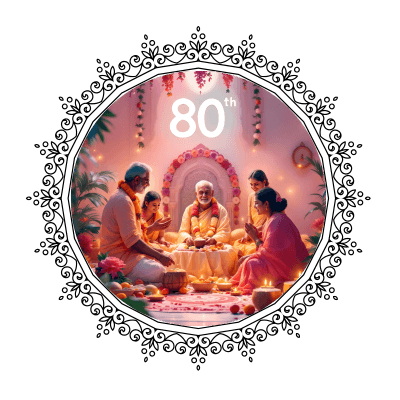Shathabhishekam, also known as Sahasra Chandra Darshan, is a significant Hindu ceremony performed to honor an individual on their 80th birthday. The term “Shathabhishekam” combines “Shata” (meaning hundred) and “Abhishekam” (meaning sacred bath or anointment), symbolizing the completion of a thousand full moons (approximately 80 years). This auspicious occasion marks a major milestone, celebrating the wisdom, experiences, and spiritual maturity accumulated over eight decades. The ceremony is conducted to express gratitude to the divine, seek blessings for continued health, prosperity, and spiritual fulfillment in the years ahead. It brings together family, friends, and the community in a joyous and spiritually enriching celebration.
1. Significance of Shathabhishekam
The Shathabhishekam ceremony holds profound cultural and spiritual importance:
Sahasra Chandra Darshan (Thousand Moon Ceremony):
- Witnessing a thousand full moons is considered a rare and highly auspicious event in one’s lifetime, symbolizing longevity and divine grace.
Spiritual Renewal:
- Marks a renewed commitment to spiritual pursuits, introspection, and the pursuit of enlightenment.
Gratitude to the Divine:
- Offers thanks to deities for their guidance, protection, and blessings throughout life.
Family and Community Bonding:
- Strengthens relationships among family members and fosters unity and continuity across generations.
Karmic Purification:
- Aims to cleanse accumulated negative karmas and seeks forgiveness for past actions.
Reaching the age of eighty is seen as entering a venerable stage of life, where one’s wisdom and experiences serve as a guiding light for future generations.
2. Rituals and Procedures
The Shathabhishekam ceremony involves elaborate rituals performed by learned priests following Vedic traditions:
Purification (Shuddhi):
Space Cleansing:
- The venue is purified with holy water, incense, and the chanting of sacred mantras to create an auspicious atmosphere.
Personal Cleansing:
- The celebrant and their spouse (if applicable) take a ritual bath and wear traditional attire, symbolizing purity and renewal.
Sankalpa (Declaration of Intent):
- The individual articulates their intentions, seeking blessings for health, peace, and spiritual advancement.
Ganapati Puja:
- Worship of Lord Ganesha to remove obstacles and ensure the smooth conduct of the ceremony.
Navagraha Puja:
- Honoring the nine planetary deities to harmonize planetary influences and mitigate any adverse astrological effects.
Ayushya Homa (Homa for Longevity):
- Performing a fire ritual dedicated to Ayush Devata, the deity of life, to invoke blessings for continued health and longevity.
Mrityunjaya Homa:
- Conducting a homa for Lord Shiva, chanting the Maha Mrityunjaya Mantra to seek protection from ailments and untimely death.
Dhanvantari Homa:
- Invoking Lord Dhanvantari, the divine healer, for health and well-being.
Kalasha Sthapana:
- Establishing sacred pots (Kalash) symbolizing various deities and cosmic energies.
Abhishekam (Holy Bathing):
- The celebrant is ceremonially bathed with sacred substances like milk, honey, curd, turmeric, sandalwood paste, and holy water, signifying purification and rejuvenation.
Renewal of Marital Vows (Mangalya Dharanam):
If married, the couple may renew their marital vows.
- The husband ties a new Mangalsutra (sacred necklace) around his wife’s neck, symbolizing continued commitment and love.
Homa Offerings (Ahuti):
- Offering ghee, herbs, grains, and other sacred items into the fire while chanting specific Vedic mantras.
Purna Ahuti (Final Offering):
- Concluding the homa with the final offering and universal prayers for peace, prosperity, and the well-being of all.
Ashirvachanam (Blessings):
- Receiving blessings from priests, elders, family members, and friends, wishing for health, happiness, and spiritual fulfillment.
Aarti and Prasad Distribution:
- Performing aarti (waving of lighted lamps) and distributing prasad (blessed food) to all attendees.
Cultural Celebrations:
- The ceremony may be followed by cultural programs, music, dance, and a feast, celebrating the joyous occasion.
3. Benefits of Performing Shathabhishekam
Engaging in the Shathabhishekam ceremony is traditionally believed to confer numerous benefits:
Health and Vitality:
- Invokes divine blessings for sustained physical and mental well-being.
Longevity:
- Seeks grace for a long, healthy, and fulfilling life ahead.
Spiritual Growth:
- Encourages deeper engagement with spiritual practices and introspection.
Karmic Cleansing:
- Aims to purify past negative karmas, alleviating associated burdens.
Family Harmony:
- Strengthens familial bonds, promoting love, respect, and unity among relatives.
Peace and Contentment:
- Fosters inner peace, reducing stress and enhancing overall happiness.
Astrological Remedies:
- Mitigates malefic effects of planetary positions, harmonizing cosmic influences.
Conclusion
Celebrating the 80th birthday with the Shathabhishekam ceremony is a profound expression of gratitude, joy, and spiritual aspiration. It honors the individual’s journey through life, acknowledging the wisdom gained and the challenges overcome. Surrounded by loved ones, the celebrant embraces this significant milestone with humility and a renewed commitment to personal growth and spiritual enlightenment. The ceremony not only enriches the individual’s life but also inspires family and community members to uphold cultural traditions and values. It serves as a reminder of the enduring pursuit of righteousness (Dharma), the importance of family unity, and the continuous quest for inner peace and fulfillment.


